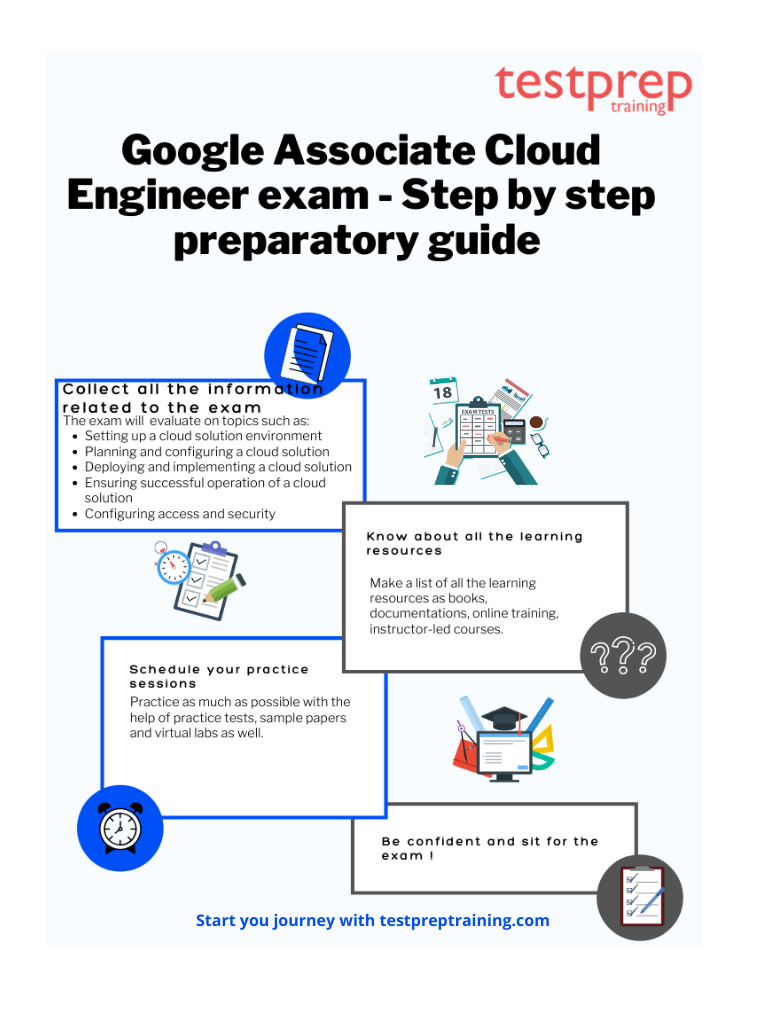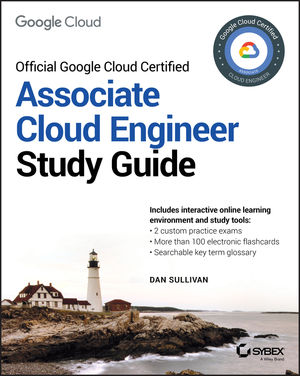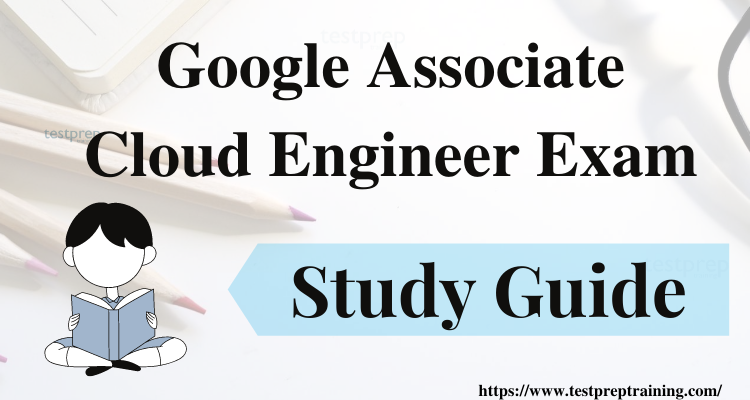An Google Associate Cloud Engineer deploys applications, monitors operations, and manages enterprise solutions. Cloud computing sector has boomed a lot in the past few years. Today, many people interested in IT want to study cloud computing because it offers high-paying jobs and is expected to grow quickly in the future. This test helps you get better at using two different kinds of computer systems, one that’s out on the internet and one that’s inside your own place. You’ll also figure out how to use Google’s computer control panel and special typing commands to do lots of different jobs on Google’s computer system, whether Google runs it or you make it yourself.
Skills Assessed
The Google Associate Cloud Engineer Certification Exam assesses your ability to –
- Firstly, set up a cloud solution environment
- Secondly, plan and configure a cloud solution
- Then, deploy and implement a cloud solution
- Also, ensure successful operation of a cloud solution
- Moreover, configure access and security
Who should take this exam?
This test is meant to see if you have the right technical skills for the job you want. The best way to prepare is by actually doing the tasks that are part of the job. If you feel like you need more practice, you can use the practice labs on Qwiklabs and make use of Google Cloud’s free tier to get better at what you know and can do.
Google Associate Cloud Engineer Study Guide
Getting certified in this field is tough because there are a lot of people trying to do the same thing. However, with the correct resources and a good plan, passing the exam can be manageable. There are many resources available for you to prepare, but you should be cautious and pick the ones that are trustworthy. Let’s take a look at the recommended resources and talk about them one by one.

Step 1- Understand the Exam Details
To start preparing, it’s crucial to understand the exam details and rules. Having this information is important before you begin your journey to get ready for the exam. Also, make sure you know what’s in the exam by looking at the exam course. Since this exam covers a lot of material, it’s a good idea to use the Official Exam Guide provided by Google to learn more about what’s in the exam. The exam is divided into five main areas, and each of these has different topics. You need to study all of these topics to do well in the exam. Plan your study time based on these course areas to get better prepared. Here are the Google Associate Cloud Engineer Course domains:
1. Setting up a cloud solution environment (17.5%)
1.1 Setting up cloud projects and accounts. Activities include:
- Creating a resource hierarchy
- Applying organizational policies to the resource hierarchy
- Granting members IAM roles within a project
- Managing users in Cloud Identity (manually and automated) (GCP Documentation: Cloud Identity)
- Enabling APIs within projects (GCP Documentation: Enabling an API in your Google Cloud project)
- Provisioning and setting up products in Google Cloud’s operations suite
1.2 Managing billing configuration. Activities include:
- Creating one or more billing accounts (GCP Documentation: Create, modify, or close your Cloud Billing account)
- Linking projects to a billing account (GCP Documentation: Modify a project’s billing settings)
- Establishing billing budgets and alerts (GCP Documentation: Set budgets and budget alerts)
- Setting up billing exports
1.3 Installing and configuring the command line interface (CLI), specifically the Cloud SDK (e.g., setting the default project).
2. Planning and configuring a cloud solution (17.5%)
2.1 Planning and estimating Google Cloud product use using the Pricing Calculator
2.2 Planning and configuring compute resources. Considerations include:
- Selecting appropriate compute choices for a given workload (e.g., Compute Engine, Google Kubernetes Engine, Cloud Run, Cloud Functions) (GCP Documentation: Choosing the right compute option in GCP: a decision tree)
- Using preemptible VMs and custom machine types as appropriate (GCP Documentation: Custom Machine Types)
2.3 Planning and configuring data storage options. Considerations include:
- Product choice (e.g., Cloud SQL, BigQuery, Firestore, Spanner, Bigtable) (GCP Documentation: Google Cloud products)
- Choosing storage options (e.g., Zonal persistent disk, Regional balanced persistent disk, Standard, Nearline, Coldline, Archive)
2.4 Planning and configuring network resources. Tasks include:
- Differentiating load balancing options (GCP Documentation: Cloud Load Balancing overview)
- Identifying resource locations in a network for availability (GCP Documentation: Geography and regions)
- Configuring Cloud DNS (GCP Documentation: Cloud DNS )
3. Deploying and implementing a cloud solution (25%)
3.1 Deploying and implementing Compute Engine resources. Tasks include:
- Launching a compute instance using the Google Cloud console and Cloud SDK (gcloud) (e.g., assign disks, availability policy, SSH keys)
- Creating an autoscaled managed instance group using an instance template (GCP Documentation: Creating managed instance groups)
- Generating/uploading a custom SSH key for instances (GCP Documentation: Managing SSH keys in metadata)
- Installing and configuring the Cloud Monitoring and Logging Agent
- Assessing compute quotas and requesting increases (GCP Documentation: Requesting an increase in quota)
3.2 Deploying and implementing Google Kubernetes Engine resources. Tasks include:
- Installing and configuring the command line interface (CLI) for Kubernetes (kubectl)
- Deploying a Google Kubernetes Engine cluster with different configurations including AutoPilot, regional clusters, private clusters, etc.
- Deploying a containerized application to Google Kubernetes Engine (GCP Documentation: Deploying a containerized web application)
- Configuring Google Kubernetes Engine application monitoring and logging (GCP Documentation: Overview of Google Cloud’s operations suite for GKE)
3.3 Deploying and implementing App Engine, Cloud Run, and Cloud Functions resources. Tasks include, where applicable:
- Deploying an application and updating scaling configuration, versions, and traffic splitting (GCP Documentation: Splitting Traffic)
- Deploying an application that receives Google Cloud events (e.g., Pub/Sub events, Cloud Storage object change notification events)
3.4 Deploying and implementing data solutions. Tasks include:
- Initializing data systems with products (e.g., Cloud SQL, Firestore, BigQuery, Spanner, Pub/Sub, Bigtable, Dataproc, Dataflow, Cloud Storage) (GCP Documentation: Initialization actions)
- Loading data (e.g., command line upload, API transfer, import/export, load data from Cloud Storage, streaming data to Cloud Pub/Sub) (GCP Documentation: Introduction to loading data)
3.5 Deploying and implementing networking resources. Tasks include:
- Creating a VPC with subnets (e.g., custom-mode VPC, shared VPC) (GCP Documentation: Using VPC networks)
- Launching a Compute Engine instance with custom network configuration (e.g., internal-only IP address, Google private access, static external and private IP address, network tags) (GCP Documentation: Creating instances with multiple network interfaces)
- Creating ingress and egress firewall rules for a VPC (e.g., IP subnets, network tags, service accounts) (GCP Documentation: VPC firewall rules overview)
- Creating a VPN between a Google VPC and an external network using Cloud VPN (GCP Documentation: Cloud VPN overview)
- Creating a load balancer to distribute application network traffic to an application (e.g., Global HTTP(S) load balancer, Global SSL Proxy load balancer, Global TCP Proxy load balancer, regional network load balancer, regional internal load balancer) (GCP Documentation: External TCP/UDP Network Load Balancing overview)
3.6 Deploying a solution using Cloud Marketplace. Tasks include:
- Browsing Cloud Marketplace catalogue and viewing solution details (GCP Documentation: GOOGLE CLOUD MARKETPLACE)
- Deploying a Cloud Marketplace solution (GCP Documentation: Creating Deployments with Google Cloud Platform Marketplace)
3.7 Implementing resources via infrastructure as code. Tasks include:
- Building infrastructure via Cloud Foundation Toolkit templates and implementing best practices
- Installing and configuring Config Connector in Google Kubernetes Engine to create, update, delete, and secure resources
4. Ensuring successful operation of a cloud solution (20%)
4.1 Managing Compute Engine resources. Tasks include:
- Managing a single VM instance (e.g., start, stop, edit configuration, or delete an instance) (GCP Documentation: Virtual machine instances)
- Remotely connecting to the instance
- Attaching a GPU to a new instance and installing CUDA libraries (GCP Documentation: Adding or removing GPUs)
- Viewing current running VM inventory (instance IDs, details) (GCP Documentation: Instance life cycle)
- Working with snapshots (e.g., create a snapshot from a VM, view snapshots, delete a snapshot) (GCP Documentation: Creating persistent disk snapshots)
- Working with images (e.g., create an image from a VM or a snapshot, view images, delete an image) (GCP Documentation: Images)
- Working with instance groups (e.g., set autoscaling parameters, assign instance template, create an instance template, remove instance group) (GCP Documentation: Instance groups)
- Working with management interfaces (e.g., Google Cloud console, Cloud Shell, Cloud SDK) (GCP Documentation: Cloud management tools)
4.2 Managing Google Kubernetes Engine resources. Tasks include:
- Viewing current running cluster inventory (nodes, pods, services) (GCP Documentation: GKE Dashboards)
- Browsing the container image repository and viewing container image details (GCP Documentation: gcloud container images list)
- Working with node pools (e.g., add, edit, or remove a node pool) (GCP Documentation: Node pools)
- Working with pods (e.g., add, edit, or remove pods) (GCP Documentation: Pod)
- Working with services (e.g., add, edit, or remove a service) (GCP Documentation: About Google Cloud services)
- Working with stateful applications (e.g. persistent volumes, stateful sets) (GCP Documentation: Deploying a stateful application)
- Managing Horizontal and Vertical autoscaling configurations
- Working with management interfaces (e.g., Google Cloud Console, Cloud Shell, Cloud SDK, kubectl) (GCP Documentation: Cloud management tools)
4.3 Managing Cloud Run resources. Tasks include:
- Adjusting application traffic splitting parameters (GCP Documentation: Splitting Traffic)
- Setting scaling parameters for autoscaling instances (GCP Documentation: Autoscaling groups of instances)
- Determining whether to run Cloud Run (fully managed) or Cloud Run for Anthos
4.4 Managing storage and database solutions. Tasks include:
- Managing and securing objects in and between Cloud Storage buckets (GCP Documentation: Moving and renaming buckets)
- Setting object life cycle management policies for Cloud Storage buckets (GCP Documentation: Object Lifecycle Management)
- Executing queries to retrieve data from data instances (e.g., Cloud SQL, BigQuery, Cloud Spanner, Cloud Datastore, Cloud Bigtable) (GCP Documentation: Querying Cloud Storage data)
- Estimating costs of a BigQuery query (GCP Documentation: Estimating storage and query costs)
- Backing up and restoring data instances (e.g., Cloud SQL, Cloud Datastore) (GCP Documentation: Restoring an instance)
- Reviewing job status in Cloud Dataproc, Cloud Dataflow, or BigQuery (GCP Documentation: Life of a Dataproc Job)
4.5 Managing networking resources. Tasks include:
- Adding a subnet to an existing VPC (GCP Documentation: Using VPC networks)
- Expanding a subnet to have more IP addresses (GCP Documentation: gcloud compute networks subnets expand-ip-range)
- Reserving static external or internal IP addresses (GCP Documentation: Reserving a new static external IP address)
- Working with CloudDNS, CloudNAT, Load Balancers and firewall rules
4.6 Monitoring and logging. Tasks include:
- Creating Cloud Monitoring alerts based on resource metrics
- Creating and ingesting Cloud Monitoring custom metrics (e.g., from applications or logs)
- Configuring log sinks to export logs to external systems (e.g., on-premises or BigQuery) (GCP Documentation: Exporting with the Logs Viewer)
- Configuring log routers
- Viewing and filtering logs in Stackdriver (GCP Documentation: Advanced logs queries)
- Viewing specific log message details in Stackdriver (GCP Documentation: Viewing logs (Classic))
- Using cloud diagnostics to research an application issue (e.g., viewing Cloud Trace data, using Cloud Debug to view an application point-in-time) (GCP Documentation: Error Reporting)
- Viewing Google Cloud status (GCP Documentation: Google Cloud Status Dashboard)
5. Configuring access and security (20%)
5.1 Managing identity and access management (IAM). Tasks include:
- Viewing IAM policies
- Creating IAM policies
- Managing the various role types and defining custom IAM roles (e.g., primitive, predefined and custom) (GCP Documentation: Basic concepts)
5.2 Managing service accounts. Tasks include:
- Creating service accounts
- Using service accounts in IAM policies with minimum permissions (GCP Documentation: Service accounts)
- Assigning service accounts to resources (GCP Documentation: Creating and enabling service accounts for instances)
- Managing IAM of a service account
- Managing service account impersonation
- Creating and managing short-lived service account credentials
5.3 Viewing audit logs
Step 2- Explore Learning Resources
The demand for Google Cloud Certified Associate Cloud Engineer exam has accelerated and so there are abundant resources in the marketplace for your preparations. It is necessary to choose the ones that best suit you and are authentic. Here are some recommended Google Associate Cloud Engineer Study Material for you to explore-
Online Training
There are various sites that provides the online training for this exam. the online training is the best way to prepare for the exam while developing strong understanding of the concepts. The online classes also provide you with good reading material like notes or recommends books that might be beneficial for you. Google has itself recommended some trainings that might help you in scoring well and that are prepared officially by google itself via coursera and other sites.
Complete the recommended curriculum in Google Associate Cloud Engineer Training:
Broaden your knowledge with additional self-paced labs and quests:
- Firstly, Quest: Baseline: Infrastructure
- Secondly, Quest: Cloud Engineering
- Then, Quest: Kubernetes in Google Cloud
- Also, Hands-on lab: Cloud Run – Hello Cloud Run
- Moreover, Hands-on lab: Deploying an Application to App Engine Flexible
Instructor led trainings
Instructor led trainings are also one of the best options to prepare for the exam. the instructors who are well versed with this and have excelled in this field are on board for teaching in the best possible way. Again, you can find many reliable sites that provide online training and also provide you additional resources that can help you a lot. Google recommends Google Associate Cloud Engineer Online Trainings through the following labs:
Complete the recommended curriculum:
- To begin with, Google Cloud Fundamentals: Core Infrastructure
- Also, Architecting with Google Compute Engine
Hands – on trainings
Practicing and learning to apply the concepts in real life is very important. This exam tests your competency for a job so all your concepts should be crystal clear and you should know their application too. Google recommends trainings through the following labs:
- Firstly, Quest: GCP Essentials
- Secondly, Quest: Baseline: Infrastructure
- Thirdly, Quest: Cloud Engineering
- Subsequently,Quest: Networking in the Google Cloud
- Further, Quest: Kubernetes in the Google Cloud
- Also, Hands-on lab: Cloud Run – Hello Cloud Run
- Additionally,Hands-on lab: Deploying an Application to App Engine Flexible

Books – Your best friends
Books have been an age old tradition and essential ingredient when it comes to preparing for any exam. They provide deep understanding of the exam concepts. Also Google Associate Cloud Engineer Books offer real life scenarios that help you prepare for a practical exam. We recommend you to refer the Official Google Cloud Certified book by Dan Sullivan for the preparation of your exam.
Google documentation
Google documentation is the most authentic resource for preparation and that too free of cost. You can go to official site of google for this exam and can find the documentations. Google has divided its documentations in the following four major sections:
You can explore these documentations and can find absolutely reliable and quality content for your preparation.
Step 3- Evaluate yourself – Try Practice Tests
Practice is what decides your future. You should try to take Google Associate Cloud Engineer Practice Tests as much as you can as this will never let you down. Practising will help you determine where do you lack in performing best and will also help you in getting more confident on the day of exam by eradicating your silly mistakes. Try to solve multiple practice tests. They will let you identify the loopholes in your preparation and will help you in reaching the next level of preparation. Such practice tests boost your confidence and improve your skills. Start Practising Now!



